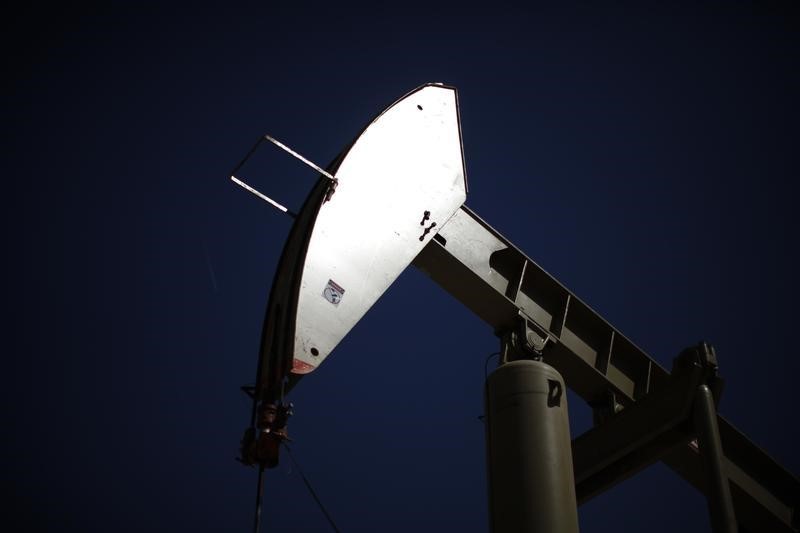By Devika Krishna Kumar
NEW YORK (Reuters) - Fifty-stage frack jobs. Fifteen-foot cluster spacing. More than 2,000 pounds of proppant concentrate per foot.
Top U.S. shale producers are pushing fracking technology to new extremes to get more oil out of their wells, as they weather lower-for-longer oil prices.
While the impact of the techniques may be scarcely noticeable on current U.S. output with so few wells in operation, it could mean drillers are able to accelerate production more fiercely than ever once prices recover.
The hunt for the next big technology to transform the process of fracking is still on, with companies looking at methods such as using carbon dioxide to coax more oil out of wells that have already been hydraulically fractured.
Commentary from executives in recent weeks suggests they are doubling down on existing accomplishments and innovations to boost production.
Pioneer Natural Resources is increasing the length of stages in its wells, Hess Corp (NYSE:HES) is raising the total number of stages, EOG Resources (NYSE:EOG) is drilling in extremely tight windows, while Whiting Petroleum Corp and Devon Energy Corp (NYSE:DVN) have loaded up more sand in their wells, fourth-quarter earnings call comments show.
Sector experts say these techniques could boost initial output per well by between 5 and 50 percent, demonstrating the resilience of the industry.
"We have got to keep moving ahead in terms of our knowledge base so that when things improve we can hit it with all cylinders," Pioneer COO, Tim Dove, said on a recent quarterly results call.
The company plans to cut spacing between clusters, or small perforations that provide fluid and sand access to the formation, to as little as 15 feet - a move it said would have been "unheard of" in the past.
For a typical well in the Bakken, a jump to 15-foot spacing could easily boost initial output by as much as 50 percent, Monte Besler, who runs FRACN8R Consulting in North Dakota, estimated.
Many of the techniques have been around for the last four years as the U.S. shale boom took off, but drillers are deploying them at a greater rate as prices show little sign of recovering significantly amid concerns about a global glut.
"The increase in proppant amounts and fluid amounts and the decrease in cluster spacing, all of those are directions that industry in general has been headed," said Jennifer Miskimins, senior consulting engineer with Barree & Associates in Lakewood, Colorado.
"In some places it is helping with long-term recoveries and that's why we're starting to see people push the envelope a little bit."
UPGRADING THE HIGH GRADING
Drillers have already idled slower rigs, shifted crews and high-speed rigs to "sweet spots" with the most oil during the punishing 20-month price rout.
With the major shale companies ready to crank up the spigots if oil prices recover to $40-$45 a barrel, the latest steps are all the more significant.
For many, efforts to boost production while keeping costs in check are already paying off.
In the fourth quarter, Pioneer slashed stage lengths by 60 percent, added one cluster per stage, and pumped more fluid - about 36 barrels per foot, up from 30 - in all of its wells.
The results? Initial production jumped by more than 15 percent from the prior quarter to 2,200 barrels per day in about 22 of its wells in the Permian, the company said, describing the result as "exceedingly strong."
A frack stage is a portion of the horizontal section of the well. Typically, the larger the number of stages used, the better initial production is expected to be.
Hess' decision to increase stage counts by about 40 percent to 50 delivered a more than 20-percent average increase in initial production rates for basically the same cost, the company said.
The costs for producers for these techniques is also dropping dramatically as service providers compete aggressively for the limited amount of work on offer, experts said.
POUNDING SAND
Others are turning to sand, which is pumped with a mixture of chemicals and water to induce pressure and crack rocks.
Whiting, Devon and Continental Resources Inc have all loaded up well completions with higher proppant concentrations, or essentially, sand.
The benefit for a company like Devon, which is pumping about 2,500 to 2,700 pounds per lateral foot in some of its wells, could be as much as a 50 percent rise in initial rates, Besler estimated.
The moves highlight that these companies are not yet considering raising the white flag in the face of the downturn.

"Even in 2016 we're changing what we're doing in terms of optimization, we're pushing the limits." Pioneer's Dove said.